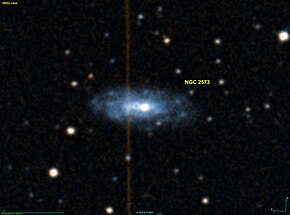| NGC 2573 | |
|---|---|
 NGC 2573 | |
| Observation data (J2000 epoch) | |
| Constellation | Octans |
| Right ascension | 01h 41m 38.012s [1] |
| Declination | −89° 20′ 04.267″ [1] |
| Characteristics | |
| Type | Sb |
| Apparent size (V) | 0.85′ × 0.34′ [1] |
| Notable features | Closest NGC object to the south celestial pole. |
| Other designations | |
| NGC 2573, PGC 6249, ESO 1-1 | |
NGC 2573 (also known as Polarissima Australis[1]) is a barred spiral galaxy located in the constellation Octans, discovered in 1837 by John Herschel.[2] It is the closest NGC object to the south celestial pole.[1]
See also
[edit]- NGC 3172 - the closest NGC object to the north celestial pole.
References
[edit]- ^ a b c d e "NGC 2573". sim-id. Retrieved 2020-05-29.
- ^ "New General Catalog Objects: NGC 2550 - 2599". cseligman.com. Retrieved 2020-05-30.
External links
[edit]- SIMBAD: NGC 2573 -- Galaxy
- NGC 2573 on WikiSky: DSS2, SDSS, GALEX, IRAS, Hydrogen α, X-Ray, Astrophoto, Sky Map, Articles and images
Well, that’s interesting to know that Psilotum nudum are known as whisk ferns. Psilotum nudum is the commoner species of the two. While the P. flaccidum is a rare species and is found in the tropical islands. Both the species are usually epiphytic in habit and grow upon tree ferns. These species may also be terrestrial and grow in humus or in the crevices of the rocks.
View the detailed Guide of Psilotum nudum: Detailed Study Of Psilotum Nudum (Whisk Fern), Classification, Anatomy, Reproduction